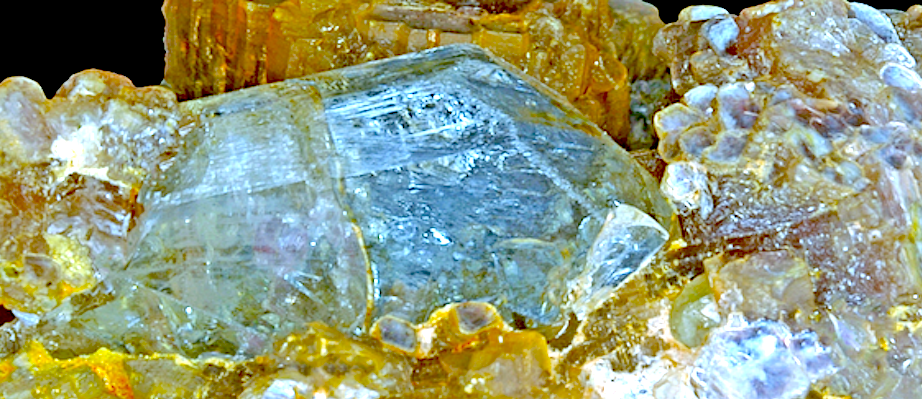The world of gemstones is vibrant and dynamic, with precious stones have long having been considered to have great aesthetic, spiritual, and practical significance. Topaz, in its dazzling variety of colors, is one of the most popular and gorgeous gems around. Many hues are naturally occurring, while others are created using stone treatment techniques.
Topaz is an aluminum silicate mineral with fluorine. This gem grows as crystal formations within the veins and cavities of igneous rocks. Associated with minerals such as quartz, fluorite, and tourmaline, it can be found in large orthorhombic crystals with vitreous luster and white streaks,
With a Mohs hardness scale rating of 8, topaz is the third hardest gemstone on the planet after diamond (10) and sapphire and ruby (both 9). As a piezoelectric gem, it can accumulate an electrical charge when exposed to pressure, which is said to last for hours.
Yellow, pink, orange, red, purple, and blue topaz are among the most expensive and uncommon natural topaz hues. The Portuguese people refer to the colorless topaz as “pingos d’água,” which translates as “drops of water.” Since the vast majority of topaz is colorless, cut stones are often referred to as “silver topaz.”

Natural pink and natural blue topaz have always been extremely rare. Natural blue topaz deposits may be found worldwide, with the finest material coming from Brazil, Russia, and Zimbabwe. Blue topaz is considered one of the birthstones for November and December, or Sagittarius, in Western Astrology.
Gem enhancement
Success
You are now signed up for our newsletter
Success
Check your email to complete sign up
The methods of artificial enhancement have not changed much over the years. Many known types of treatment are generally accepted, with the exception of the extremely thin coatings applied to quartz and topaz which wear and tear if not handled with care.
Heat treatment is generally considered a continuation of the natural process, since it only uses heat, and produces stable colors. Heating brownish-orange topaz (known as ‘pinking’) removes the brown from the color, leaving a pure pink. Heating will make yellow-brown or blue topaz colorless, but color can be restored through oils or other agents that are ‘impregnated’ into the stone to restore the hues.
In terms of both value and appeal, blue topaz is unquestionably the most significant irradiated gem. Various radiation procedures determine whether the stone is sky, Swiss, or London blue. Other hues range from electric blue to neon blue.
Topaz is also known as a pleochroic gemstone, which means that various hues may be seen from different angles when the gem is moved about in the light. For example, a Red Topaz may exhibit dark reds, yellows, and pinkish reds depending on the angle from which it is viewed.
History and lore
Although the term Topaz has a long and illustrious history, it is likely that it often referred to a completely different stone called chrysolite, or peridot, in the ancient past; as all yellow stones were called topazes. Pliny the Elder (23 – 79 AD), author of Natural History, connected the name to a legendary gem island in the Red Sea via the Greek term “Topazos,” which means “to seek.” The island lies about 60 miles southeast of Egypt’s Ras Banas Peninsula and is now called Zabargad Island.
The term ‘imperial topaz’ was first coined in Russian literature in the eighteenth century. At the time, the Ural Mountains were the world’s largest source of topaz, and the pink topaz mined there was named in honor of Czar Nicholas II, who reigned during that time. The gemstone was so rare it was only available for purchase by members of the royal family.
Topaz is unique in that it can develop into massive crystals. In 1944, a 350-tonne crystal was claimed to have been discovered in Mugui, Brazil.
Another large crystal was discovered in Brazil in 1740. Believed to be a 1680 carat diamond, it was brought to Portugal to be set in the Royal Crown jewels. The diamond turned out to be a huge clear Topaz. This stunning gemstone is still on display today.
Topaz was considered to be a source of power by the ancient Greeks. During the Renaissance (roughly the time between the 1300s and the 1600s), many in Europe believed that topaz could break magic spells and remove rage.
The Ancient Romans believed that the gem could help protect against poison and change color when danger was near to warn its wearer. The Egyptians believed the stone received its color from the golden glow of the Sun God – Ra.
In ancient India, a Hindu magician possessed one such stone, which he would loan out on occasion. This restorative jewel was requested once by a great raja during the heat of a battle. The magician took it to the fighting scene, but while searching for the rajah, he was overcome by an evil force and fell, dying to the ground. As he breathed his last, he heard a wounded soldier crying for help. With the last of his strength, he threw the topaz to the man gasping that he must place the gem against his heart. The soldier did so and miraculously lived to tell the tale. That is why for ages, many people in India have held the belief that wearing topaz over the heart ensures a long life for themselves and their loved ones.
A legendary story about the beautiful gem tells how Lady Hildegarde, the wife of Theodoric, Count of Holland, reportedly gave a huge golden topaz to a convent in the 1100s. The stone was so bright that it used to illuminate the chapel at night by which the congregation read their prayers. At one point, a thieving monk was said to have stolen the precious specimen. Though he did not repent of his crime, the monk became afraid that he would be accused of sacrilege, so he threw the topaz into the sea. Neither the monk nor the topaz was ever seen again.















